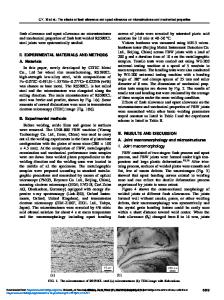Effects of CaF 2 Coating on the Microstructures and Mechanical Properties of Tungsten Inert Gas Welded AZ31 Magnesium Al
- PDF / 1,095,008 Bytes
- 9 Pages / 593.972 x 792 pts Page_size
- 15 Downloads / 315 Views
RODUCTION
ACTIVATED tungsten inert gas (A-TIG) welding is receiving increased attention for its deep penetration and satisfactory welded joints.[1,2] The arc constriction and the reversed Marangoni convection are considered to be the two main factors for increasing the penetration of an A-TIG welding pool. Dunn et al.[3] and Li et al.[4] consider that greater penetration of A-TIG welding is due to constriction of the electric arc caused by some elements of fluxes (mainly oxygen and fluorine). This effect increases the anode current density and arc force acting on the welding pool. Heiple and Roper[5] and Lu et al.[6] support that increase in weld penetration results from a change of liquid flow in the welding pool, which is caused by the interaction of flux and liquid metal. Relatively few investigations were carried out to determine the effect of activating flux on microstructures and mechanical properties of TIG welded AZ31 magnesium alloy joints. Liu et al.[7,8] and Zhang et al.[9,10] studied the effects of oxides, chlorides, and fluorides on microstructures and mechanical properties of TIG welded magnesium alloy joints. They found that the additions of chlorides and fluorides caused the constriction of electric arc by changing the arc conducting channel and then affected arc shape. However, oxides JUN SHEN, Vice Professor, and DONG PENG and DAN WANG, Masters, are with the College of Material Science and Engineering, Chongqing University, Chongqing 400044, People’s Republic of China. Contact e-mail: [email protected] LINZHI WANG, formerly Master with the College of Material Science and Engineering, Chongqing University, is now Researcher with Chongqing Institute of Green and Intelligent Technology, Chinese Academy of Sciences, Chongqing 404100, People’s Republic of China. Manuscript submitted October 9, 2011. Article published online July 11, 2012 METALLURGICAL AND MATERIALS TRANSACTIONS A
had little influence on arc shape, and the increase in weld penetration caused by the additions of oxides was due to a change of liquid flow of molten metal in the welding pool. The grains in the fusion zone (FZ) of the welded joint prepared with flux were coarser than that sample prepared without flux. The tensile strength was lower for the flux-prepared weld. Wang et al.[11] studied TiO2 flux on microstructures and mechanical properties of TIG welded AZ31 magnesium alloy joints. They pointed out that greater weld penetration was caused by a change of liquid flow in the welding pool. Modenesi et al.[12] researched the influences of single-component oxides (SiO2, Cr2O3, etc.) and fluorides (CaF2, AlF3, etc.) on the weld appearance and weld penetration of TIG welded austenitic stainless steel plates. They pointed out that the weld penetration increased because of the arc constriction caused by fluorine atoms and other metal vapors. The investigation on the effects of the amount of activating flux on the microstructures and mechanical properties of the TIG welded magnesium alloy joints is very limited. Moreover, the intrinsic mechanisms of the forma
Data Loading...











